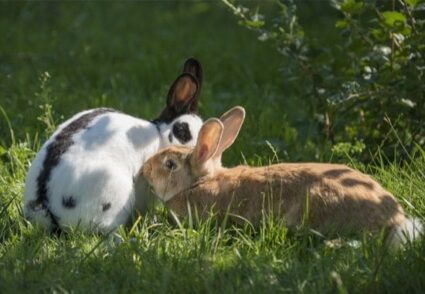Rabbits are intelligent, social animals that make good pets. Due to a need for company, a rabbit that lives on its own can experience loneliness and health problems. A lonely rabbit might become withdrawn or depressed. Behavioral problems, such as aggression and biting, are also possible.
Rabbits should always live in pairs, as they can become stressed or sick if kept alone. They are sociable animals that need the company of other rabbits. One male and one female is the best pairing. Make sure they’re spayed and neutered before introducing them.
There’s no guarantee that two rabbits will get along together. However, if you introduce them slowly and carefully, they should form a close bond. We’ll look closely at the best rabbit pairings and what you can do to give a pair of rabbits an excellent chance of becoming lifelong companions.
Do Rabbits Need to Live Together?
Domestic rabbits are descended from European wild rabbits. They are naturally social animals that seldom live alone in the wild.
According to research by the University of Rochester, wild rabbits live in complex social structures consisting of many individuals. Each group typically has a dominant male and other subordinate males and females.
Rabbits are happiest when they’re living with one or more other rabbits. They form strong bonds, to the point that they’re inseparable. Bonded rabbits eat, play, cuddle, groom and sleep together.
A domesticated rabbit kept on its own can become lonely and depressed. They’re not intended to live alone, without the company of other rabbits. This may cause the following issues:
- Refusal to eat or drink, leading to illness
- Become lethargic and hide in their cage all day
- Destructive behaviors, such as digging and gnawing at furniture
- Become aggressive with the owner
- Over-groom or scratch until bald patches form
Unless you can spend many hours each day interacting one-on-one with your rabbit, you should always adopt two rabbits.
What Is The Best Rabbit Pairing?
Rabbits all have individual personalities. There’s never a guarantee that two rabbits will get along.
Whether two rabbits can happily coexist depends mostly on their temperaments. If they are both too dominant, they’re likely to fight with one another. The sex of the rabbits can be a significant factor.
Can Doe and Buck Rabbits Live Together?
Male rabbits are called bucks, and female rabbits are called does. Though they might look similar, their personalities can often be entirely different.
This is a good thing as their personalities often complement each other. A female rabbit will rarely be territorial around a male, for example.
One doe and one buck is the best rabbit pairing, and has the highest likelihood of success. This is mainly because, in the wild, rabbits tend to live in doe and buck pairs. They can remain in the same bond for life.
It is crucial that both rabbits are spayed and neutered before a meeting. Rabbits reproduce quickly or develop reproductive cancers if not neutered.
Can Two Female Rabbits Live Together?
There is a higher chance that two female rabbits will fight when compared to doe-buck pairings. However, as long as they’re introduced slowly, they should get along just fine.
For the best chance of success, both should be from the same litter. Sisters from the same litter often get along exceptionally well. If the two rabbits are strangers, they should be spayed before being introduced. Unspayed females can be territorial, so there’s a higher chance of fighting.
It’s possible to keep two pregnant rabbits together, as long as you have enough space. However, mothers should bond with one another before they become pregnant.
Can Two Male Rabbits Live Together?
Two male rabbits can get along together, but this is usually the least successful pairing. For a male-male pairing to work, one rabbit needs to be much more submissive than the other. They also must be neutered. Neutered males tend to be calmer and more likely to get along.
Two male rabbits from the same litter have the best chance of getting along. They must be neutered to prevent hormones from damaging their relationship. Never keep two unneutered male rabbits together, even if they’re brothers. They will fight to the point of causing injury.
What is the Best Age to Introduce Rabbits?
So, a doe and a buck make the best pairing, but age is also important. Let’s look at whether you should get two babies, two adults, or one of each.
Two Baby Rabbits
Baby rabbits, or kittens, often get along well. Before they reach 3 or 4 months’ old, they almost never fight.
This is especially true if the rabbits are part of the same litter. Brothers and sisters often have very close bonds as babies. However, keeping brother and sister rabbits together doesn’t always work out in the long-term.
Once the rabbits reach sexual maturity, their personalities change. They will smell different from each other. Rabbits that once got along well can start to fight or fall out completely when they mature. This can sometimes be prevented if you have your baby rabbit(s) spayed or neutered.
Males can be neutered when they have testicles, which usually happens after around 10-12 weeks. Females can be spayed once they reach sexual maturity, which occurs once they are about 4-6 months old.
One Adult Rabbit And One Baby Rabbit
Introducing a baby rabbit to an adult is not usually a good idea. It can work sometimes, but this pairing comes with a high risk.
Adult rabbits rarely bond well with babies. They tend to be more dominant, and can bully younger rabbits. Not to mention, young rabbits have much more energy and this can be tiring for adults.
Even if the adult rabbit does bond with the baby, this bond may break when the baby reaches sexual maturity. Rabbits’ personalities aren’t fully formed until this point. There’s every chance that the baby will not get on with the adult when it grows up.
If you’re getting a baby rabbit, get it spayed or neutered before introducing it to the older rabbit. That way, there’s more chance they’ll get on.

Two Adult Rabbits
Two adult rabbits are more likely to get along well if they’re of a similar age to one another. They’ll have similar energy levels and their personalities will be fully developed.
Both rabbits should be over one year old and be spayed or neutered before you introduce them. As discussed, spaying and neutering often reduce aggressive and territorial tendencies.
Can Different Breeds of Rabbit Live Together?
There are hundreds of different breeds of rabbits. However, despite their different appearances, all rabbit breeds are the same species (Oryctolagus cuniculus). Two rabbits of different breeds won’t behave or interact any differently than two rabbits of the same breed.
All rabbits can understand each other’s body language, which is what matters most. Rabbits don’t care what their housemate looks like, as long as it’s another rabbit, but there are other considerations.
The only factor to consider is size. If you pair an enormous Flemish Giant with a tiny Netherland Dwarf, they may get on really well. However, there may be a greater risk of injury due to the size disparity.
Regardless of breed, it’s impossible to tell whether two rabbits will get on until they meet. Introduce them slowly to achieve a successful pairing.
How to Properly Introduce Two Rabbits
Rabbits are naturally inclined to form couples. It takes them a while to bond together, but once they’re friends, they usually remain close forever.
Your local humane society or shelter will likely have lots of established rabbit pairings. There are millions of rabbits in need of homes. Rescuing an already bonded pair removes the hassle of introductions.
If you already have a single rabbit, you should introduce the new rabbit slowly and carefully. Don’t just place them together in a cage and hope for the best. Instead, follow these initial introduction steps:

Set up Two Separate Cages
Set up each rabbit in a separate cage or pen. You should choose a structure with wire mesh sides, which your rabbit can see out of. This is because the first step to introducing two rabbits is placing their cages side by side. They will need to be able to see each other.
If you already have a rabbit that lives in a wooden hutch, you’ll have to acquire a temporary cage. You can move them back to the hutch afterward, as long it’s big enough for both rabbits. Each cage or pen should contain:
- Newspaper that is topped with bedding such a straw
- Hay for your rabbit to eat
- Food bowl to hold occasional fruits and vegetables
- Water dish or sipper bottle
- A sheltered area that the rabbit can hide in, such as a cardboard box. You’ll need to replace it if your rabbit chews or tears it.
- Litter box. This should contain non-toxic paper pulp litter with a layer of hay on top.
Keep the cages in separate rooms to start with. You don’t want to introduce them too early, even by sight. When you let your rabbits out for exercise, let them out at separate times or into separate rooms.
Spay or Neuter Both Rabbits
Both rabbits need to be spayed or neutered before they meet. This serves 3 crucial purposes:
- It prevents unwanted breeding. If you have two males or two females, this isn’t an issue. However, incorrect sexing can happen.
- Removes the sex hormones that are responsible for aggression and territorial behavior. Your rabbits will get along better.
- It removes the risk of developing cancer of the reproductive organs. According to the American Association for Cancer Research, uterine cancer is the most common cancer in rabbits.
Wait for 6 weeks after both operations before moving on to the next step. This is because your rabbits may fight when they first meet, so it’s vital that their wounds are fully healed first.
Not only this, but after a spaying or neutering operation, it takes some time for the hormones to dissipate. If you wait for 6 weeks, there’s a better chance that your rabbits will get along.
Place the Cages Together
Your rabbits’ first meeting should be through the bars of their cages. Place the two cages or pens side by side. Ensure that they can see each other through the wire, with just enough space that they can’t touch. If you aren’t using cages, place the rabbits in adjoining rooms, separated by a baby gate.
This is an essential first step to introducing two rabbits. It helps them feel safe as they aren’t invading the other’s territory. Your rabbits will naturally be curious. They may come close to the bars and try to sniff each other. They may vocalize, honking, or chirping at one another. If they display aggression, don’t worry as it will subside once they get used to each other.
Once your rabbits have gotten used to each other through the bars, they’ll make it obvious. They’ll seem far more relaxed instead of being on high alert. For example, they may start lying down on either side of the divide. After several weeks of two rabbits living next to one another, they will be ready for the next step.
Bring Them Face to Face
For your rabbits’ first face-to-face encounter, choose a room that neither of them has been in. You could use a bathroom, for instance, or a spare bedroom. It’s vital that it has a neutral smell, so neither rabbit feels that its territory is being invaded.
Remove anything dangerous from the room, and add cardboard boxes to hide in. Add some hay, and perhaps some vegetables. Associating one another with a tasty treat often helps rabbits to bond more quickly.
Then, place both rabbits inside the room. Sit on the floor with them to supervise. It’s a good idea to wear thick gloves to avoid being bitten if you do need to separate them. Your rabbits will likely start to sniff each other and touch noses. They may begin circling one another. One rabbit will probably start mounting the other, to assert dominance.
What happens next depends on your rabbits’ personalities. One may accept the other’s display of dominance, or they may contest it. Gentle nipping is normal as it’s their way of establishing the pecking order.
Let your rabbits investigate each other for around 10 minutes, then separate them again. Do this every day, slowly increasing the time, until they can be around each other for an hour or more. If they fight, separate them and don’t try to reintroduce them for a few days.
Watch for Signs of Bonding
Bonding is unlikely to happen straight away. Rarely, two rabbits (usually a doe and a buck) will fall in love at first sight. However, it’s not the norm as it usually takes at least a week of daily meetings.
When your rabbits feel comfortable together, their body language will change. They’ll start lying down, grooming themselves, and eating around one another.
They may ignore each other entirely while they do this, which is a good sign. Ignoring is a sign that the rabbits feel comfortable enough to relax in each other’s presence. When two rabbits lie down touching each other, this indicates that they’re starting to bond.
The final stage of bonding is grooming each other. This is a sure sign that your two rabbits will become lifelong friends. You can encourage mutual grooming by smearing a little banana on both rabbits’ foreheads.
Once they’ve been grooming each other for a few days, it’s OK to let them live together permanently. You should never separate a pair of bonded rabbits, unless they fight or need urgent medical assistance.
Can You Keep More Than Two Rabbits Together?
Rabbits in the wild never live alone. Usually, around 10-15 individuals live together in a close group. Large warrens can be home to 100 individuals or more, living nearby.
So, it’s possible to keep multiple rabbits together, as long as there’s enough space. However, it is harder to introduce a new rabbit to a bonded pair than to introduce two single rabbits.
In the wild, rabbit groups usually consist of a dominant male rabbit and several submissive females. So, if you have a bonded doe and buck, consider getting another doe.

Introduce them slowly, using the same techniques detailed above. Treat the two already bonded rabbits as one item and don’t separate them.
The bonded rabbit of the same sex will show signs of jealousy. She may be aggressive toward the new rabbit and try to establish dominance. Let them work it out for themselves, but separate them if they fight.
Take it slowly. Wait at least two months after the new rabbit is spayed or neutered before beginning introductions. Let them get used to one another for short periods each day until they bond.
Why Are My Rabbits Not Getting Along?
Sometimes, for no apparent reason, two rabbits won’t bond together. Even a neutered doe and buck can decide that they don’t like each other. This can occur if you introduce them gradually and do everything right.
When this happens, it’s usually because both rabbits have naturally dominant personalities. Rabbits only bond once they’ve decided who’s dominant and who’s submissive. It may take two dominant rabbits a long time to figure this out.
It’s important to realize that some rabbit behaviors look aggressive, but aren’t. For instance, mounting (also called “humping”) is a natural behavior that helps rabbits decide who is the boss. It’s also normal for rabbits to gently nip one another while they’re figuring out the hierarchy.
If your rabbits are fighting, however, you will need to intervene. Real fighting can be recognized by:
- Growling
- Chasing
- Boxing
- Flattened ears and a raised tail
- Biting – this is different from gentle nipping. Biting may draw blood or tear out fur.
When two rabbits are fighting, you should intervene.
How To Stop Rabbits Fighting
If your rabbits are fighting, try to distract them. One way to do this is with a spray bottle of water. Rabbits dislike being sprayed with water. It doesn’t hurt them, but it stops them in their tracks.
When you think that a fight is about to begin, spray water at both rabbits’ heads. They will stop fighting, and will likely start grooming themselves. This may be enough to prevent them from fighting again.
If they do start to fight again, try the water one more time. If it still doesn’t work, separate your rabbits and return them to their own cages. Try introducing them again tomorrow.
On average, it takes 1 to 3 weeks of daily face time for two rabbits to become bonded. However, if both rabbits have naturally dominant personalities, it can take much longer. If they fight every time they meet, give them a few weeks apart before trying again.
After several months of attempted introductions, rabbits that still aren’t getting along probably never will. At this point, it’s best to rehome one of the rabbits and try again with another rabbit to see if they’re compatible.


can you have an unneutered male and a neutered male rabbit together? same for females?
Hi Lou: I just turned 70, wish I’d experienced the joy of having rabbits much sooner, anyway, I have 2 spayed rabbits, different breeds. Got each one at different times, love them both but they have gotten into fighting when first put together so they have conjoined pens but sometimes I get conflicting feeling that they might get along. It was a year ago I let both of them out together but they started circling each other then before I knew it, were intertwined, fighting, didn’t know where one bun started and the other ended and luckily, I had water to spray them with to break them up. There pens are in the back bedroom but I let each one out for couple of hours each night to stretch their legs. I’m just wondering if they might possibly bond in the future? Any thoughts on this? I love them both and would love to see them get along but happy just the same if they just are not meant to be bonded. Thanks for any comments you may have. Shari B.
Can you have a neutered male and a female that hasn’t been desexed together?
I had 3 neutered males and one female who was not spayed. I got each male separately one by one and the female last. They had separate cages inside but a huge 10’x15’ homemade PVC & fencing cage outside. They all got along together and with some Guinea pigs and the Russian tortoise who shared the cage over the years. I’m down to the female and tortoise but I’m getting ready to adopt another male .
Hello Lou, I am getting two young male sibling bunny rabbits from the same litter with the hope of the two of them remaining friendly and staying bonded or bonding after I get them fixed. My question is: upon bringing the brothers to my home, should I keep them in one cage, as they were with their litter, or should I give them each a separate area and wait to bring them back together after they have healed from being fixed?